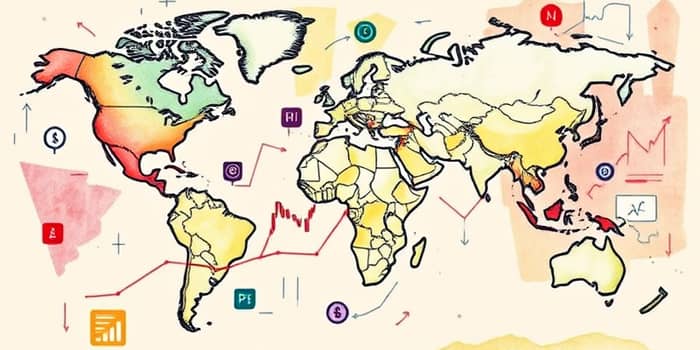
As investors start July, a confluence of economic data, policy decisions, and geopolitical events is shaping market trajectories. With global growth projections being revised downwards and trade dynamics evolving, participants must reassess strategies to navigate potential volatility. This briefing distills the major themes from H1 2025 and outlines key considerations for the coming quarter.
The World Bank now forecasts global GDP growth at 2.3% in 2025, down from a prior projection of 2.8% in 2024. This slowdown marks the slowest pace outside recessions since 2008, reflecting heightened trade tensions and enduring policy uncertainty. While the IMF’s earlier outlook anticipated a modest rise to 3.2%, incoming data have painted a more subdued picture, compelling institutions to adjust their expectations downward.
Nearly 70% of economies have seen their forecasts trimmed, as investment growth stalls and government debt climbs to record highs. If these projections hold, the 2020s will register the slowest average annual global growth since the 1960s. Despite these challenges, analysts agree that a synchronized global recession is unlikely, though both developed and emerging markets face headwinds from elevated financing costs and fragmented trade policies.
Regional divergence is a defining feature of the current economic cycle. The United States is expected to expand by just over 2% in 2025, moderated by trade disruptions and rate pressures. China’s growth rate is projected to slow to approximately 4.6%, yet avoid recession as domestic stimulus offsets external headwinds. The Eurozone is seeing a more muted recovery, with GDP growth revised down to 0.9%, and Austria flagged for a contraction of 0.3%.
India continues to lead among major markets, sustaining momentum above 6% as consumption and infrastructure investment remain robust. Smaller Asian economies are poised to outpace both the US and China, leveraging alternative trade agreements and intra-regional supply chain integration to bolster growth prospects.
The escalation of the US-China tariff war, featuring the highest duties ever applied to bilateral trade, has depressed manufacturing and export activities in both countries. European growth forecasts were swiftly downgraded following US tariff reintroductions, illustrating the spillover effects across borders. In response, nations are pursuing deepening trade ties beyond borders: the UK-India free trade agreement, post-Brexit pacts between the UK and EU, and China’s cooperation deals with Vietnam and Malaysia are reshaping global commerce patterns.
Volatility dominated the first half of 2025 as uncertainty over tariff policies and the conflict in the Middle East drove significant swings. The April 2 announcement—dubbed the Liberation Day Tariff Shock—triggered a 12% drop in the S&P 500 within a week and lifted 10-year Treasury yields by 50 basis points. A subsequent softening of the US stance restored investor confidence, leading to a strong rebound into quarter end.
Overall, developed market equities delivered +11.6% total returns in Q2, with global growth stocks, particularly technology names, posting gains of +17.7%. Notably, the Magnificent Seven stocks outperformed the broader S&P 500 by 14 percentage points, turning late-quarter optimism into an 18.6% price return despite earlier underperformance.
Sector rotations reflect shifting risk appetites and thematic drivers. Recent trends include:
Looking ahead, investors should monitor the following macro themes:
As markets open Q3, sentiment has stabilized following the shocks of Q2. Investors remain cautiously optimistic, buoyed by softer US trade rhetoric, strong corporate earnings—especially among mega-cap tech firms—and the resilience of underlying economic data. Key catalysts to watch include further tariff negotiations, central bank communications on rate paths, and earnings reports from the financial and technology sectors. While risks of renewed volatility persist, a disciplined approach to portfolio diversification and risk management will be essential for navigating the months ahead.
References













